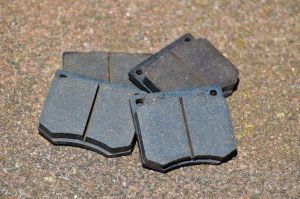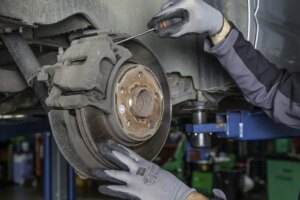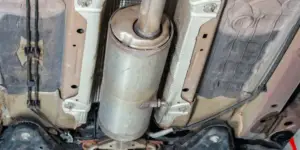One of the most important vehicle maintenance jobs is switching out your brake pads once every two to three years. People normally take their vehicle to the garage for this, but you can do it yourself. In rare cases, you may install them backwards and not notice until it’s too late. So, what should you do if you notice that your brake pads are installed backwards?
If you install your vehicle’s brake pads backward, you’re putting your life at risk. Brake pads installed incorrectly will have uneven wear. This will make braking inefficient and slower. The best thing to do is immediately remove your brake pads and install them in the correct direction. If you catch the problem early enough, it should be a simple fix.
In this article, we will give you some useful advice on dealing with brake pads that you’ve installed backward. We will show you how to identify when you’ve installed your brake pads incorrectly, and then give you information on how you can install them the right way around.
How To Tell if Your Brake Pads are Installed Backwards

Suspect your brake pads have been installed backward? Well, there are a few telltale signs that you may be dealing with a brake pad issue. If any of the following signs start to appear, then you know that you have a problem with your brake pads somewhere. It doesn’t necessarily mean they are installed backward (only a visual inspection can confirm that), but it does indicate a problem.
Sounds From the Brakes
Perhaps the first sign that something is wrong will be a screeching sound coming from the brakes. The sound can vary a little bit. Some report a high-pitched squeak, while others have reported a sound akin to that of a jet engine (long, deep rumble).
This sound is only going to happen when you brake. If it is happening without braking, then you have another issue with your vehicle.
In most cases, the sound will appear as soon as you have replaced the brake pads. When you install brake pads incorrectly, you have metal rubbing against metal. This causes that screeching sound. It’ll only get worse the longer you leave it.
The Brakes Don’t Feel as Responsive
When you install brake pads backward, they have very little grip. When brake pads are working normally, the following happens (different brake designs may vary slightly):
- You press the brake.
- Brake fluid goes through a series of hoses before it reaches the brake calipers.
- The brake calipers push the brake pads against the rotor, slowing your vehicle down.
Correctly installed brake pads have a grip on them. It is this grip that is pushed against the rotor, which makes the brakes much, much more efficient at slowing the vehicle down. When the brake pads are installed incorrectly, there is no grip pushing against the rotor. Slowing down because harder, and you often need to put more pressure on the brakes.
Over time, the problem will get a lot worse too. Incorrectly installed brake pads wear down inconsistently, and this makes it even harder for you to brake properly.
Obviously, this is incredibly dangerous. If your brakes don’t feel as responsive as they used to be, you need to get off the road and have the problem fixed immediately.
You Feel a Vibration When Braking
Remember the sounds we mentioned earlier? Well, brake pads that have been installed backward may also vibrate when you are braking. This is down to uneven wear, and the brake pads struggling to slow down the rotor.
Visual Inspection
The only way to properly confirm whether you’ve installed your brake pads backward is to look at them. It should be very easy to see as one of the following will occur:
- You have metal-to-metal contact. The ‘grip’ of the brake pad should be facing inward, toward the rotor.
- If it took a while to notice that your brake pads were installed incorrectly, then you may notice uneven wear on the brake pads.
If you installed them the right way around, you may want to check to make sure you’ve installed them properly. Brake pads can only work in one direction. They need to match up with the grooves, etc. on the rotor. It is very easy to get this wrong. In fact, it is one of the main reasons why people install brake pads backward. The grooves often line up on both sides of the brake pad!
Is It Dangerous To Have Brake Pads Installed Backwards?

The braking system is a critical system in your vehicle. If you’ve installed your brake pads incorrectly, then the brakes are going to be less responsive.
This isn’t going to be a major issue if you are doing a bit of light braking e.g., gradually slowing down for traffic lights, or bringing yourself under the speed limit gently. You can probably go a long time before you notice any issues when you are braking like this.
The real issues happen if you need to brake quickly. Because brake pads that have been installed backward have no grip on them, they take a lot longer to slow down the vehicle’s wheels. The couple of extra seconds it takes to slow down can mean the difference between life and death.
What Other Issues Occur When Brake Pads are Installed Backwards?
If you catch the issue early, then probably not a lot. However, as we said, brake pads installed incorrectly have uneven wear on them.
When brake pads have uneven wear, they put a lot more pressure on the various components around the brake pads, especially the calipers. Many people often find that brake calipers end up bent out of shape.
If you drove for an incredibly long time on poorly installed brake pads, then there is a strong chance that you could wear a groove into the rotor. If this happens, you may need to replace the rotor.
Basically, having installing brake pads backwards is going to be expensive. Not only will you need to fix the brake pads, but often you’ll need to have your whole braking system looked over to make sure there are no issues.
Fixing Brake Pads That Have Been Installed Backwards
If you caught the problem early, then you may be in luck. In some cases, you can just turn the brake pads around and fit them again. This is assuming that there is no uneven wear on the brake pads or the rotor.
If you’ve been driving for a while with the brake pads installed backward (as is the case with most people), then your best bet is to replace the whole brake pad and install them correctly the next time.
Remember, it is always best practice to replace all your brake pads at once, even if you only installed one incorrectly. This is to ensure that you don’t end up with brake pads that are wearing down slower than the other brake pads. It causes issues. If you can’t afford to replace all four at once, then at least do two (i.e. replace both front brake pads if you need to replace one of them).
Installing Brake Pads in the Right Way
We’re not going to walk you through every part of installing your brake pads here. Every vehicle is different. We are sure that you can find plenty of guides out there for your vehicle. If you still have the manual, it may even detail the exact installation instructions for your brake pads there. Our goal here is to give you advice on making sure that you don’t install them backward.
There are two things that you really need to think about here:
- The position of the brake pad’s grip.
- The position of the brake pad.
Thankfully, many brake pad manufacturers have now made it exceedingly easy to tell when you have gone wrong. They have all sorts of visual indicators to make sure that you’ve installed them correctly. Honestly, the only way to get it wrong is to not pay attention.
Remember, installing brake pads does take a decent number of automotive tools. If you don’t know what you are doing, then go to a garage. They’ll get it right. It’ll save you a lot of money in the long run, and it could even save your life.
Grip
This is the most important thing. If the grip of the brake pad isn’t facing the rotor, then you’ve installed it incorrectly. Metal should never be touching metal.
Positioning of the Brake Pad
If you have selected the right brake pads for your vehicle, then the new ones should slide in easily. The holes and the various grooves should line up properly. Your brake pads should have graphite grease supplied with them. Use it on the clips of the brake pad. It’ll make your life a lot easier.
When your new brake pads are in position, they should line up properly with the vehicle’s rotor. There should be no overhang. The brake pads should be able to move freely.
Remember, always test your brake pads before replacing the wheel. Press the brake pedal a few times and make sure that the new brake pads are making contact with the rotor.
Frequently Asked Questions
Can You Put Brake Pads In The Wrong Way?
Nowadays, it is incredibly difficult to install brake pads incorrectly if you are paying attention. However, it is possible. It is common for some people to install their brake pads backward.
What Happens If You Install Brakes Wrong?
Your vehicle will become much less efficient when braking, which is incredibly dangerous. It may also put a lot of stress on the braking system, which can be very costly to fix.
How Do You Tell If Brake Pads Are Installed Backwards?
Your vehicle’s braking will be much less efficient. There is a small chance that your vehicle will vibrate when you brake. You may also hear a high-pitched squeaking sound when you apply the brakes.













